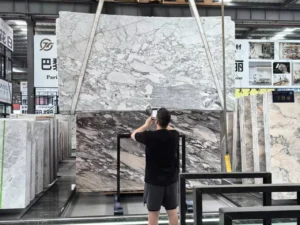
Autumn Equinox: China’s Harvest Season and the Timeless Stone
“Autumn Equinox isn’t just about equal day and night—it’s nature’s lesson in balance, a truth that echoes in how stone endures as both a harvest-era
Petit Antique marble is a kind of black breccia mined in France. Countertops, mosaics, external – interior wall and floor applications, fireplaces, fountains, pool and wall capping, stairs, window sills, and other design projects benefit greatly from this stone. Marbre Petit Antique, Petit …
Petit antique marble is a natural rock, also known as marble, whose main components are calcium and dolomite. With its rich texture, warm texture and luxurious style, it has gradually become a darling in the field of home improvement, and it is also suitable for use on kitchen countertops.
The countertop is simple and atmospheric, and the petit antique marble countertop is simple and beautiful. It has a stylish atmosphere, so it is more suitable for modern style homes with a simple atmosphere.
Although protective agents are not a panacea, petit antique marble vanities are absolutely impossible without brushing protective agents. Generally, the effect of sink protection can last about 1 year, and pollution and lesions of varying degrees will occur in 2 years. Therefore, protection is not done once and for all, and protection should be regularly refreshed.
After use, empty the water in the basin and dry the water on the petit antique marble countertop. This habit can keep the stone surface clean and reduce pollution.
As we all know, petit antique marble is afraid of strong acids and alkalis, and cleaning stone cannot be quickly ignored by the ingredients of cleaners. Generally, cleaners contain acid and alkali. If cleaners with unknown ingredients are used for a long time, the surface of the stone will lose its luster and may even cause lesions. For example, if marble is alkaline, you need to use an alkaline detergent, while granite is acidic, you need to use an acidic detergent.
Hard object scratches and wire ball abrasions will reduce the protective effect of petit antique marble and should be avoided as much as possible.
If the petit antique marble countertop has deep pollution, severe loss of light, surface aging, microcracks, breakage, or damage, please contact a professional stone care company to handle it.
ADDITIONAL INFORMATION
| MATERIAL | Marble |
| COLOUR | Black |
| COUNTRY OF ORIGIN | France |
| SURFACE FINISH | Polished, Honed, Leathered |
| USE | Kitchens, Bathrooms, Floors, Walls, Tiles, Slabs |
| AVAILABILITY | Please check stock availability with HRST STONE to visiting. Stone samples are also not available for every stone selection, please enquire for availability. |
Petit Antique marble is a kind of black breccia mined in France. Countertops, mosaics, external – interior wall and floor applications, fireplaces, fountains, pool and wall capping, stairs, window sills, and other design projects benefit greatly from this stone.petit antique marble, noir petit antique, petit antique bechantillon, and noir grand antique marble are some of the other names for it. Polished, sawn cut, sanded, rockfaced, sandblasted, tumbled, and more finishes are available for petit antique marble.
Petit antique marble is a cool black background with white veins, harmonious and unified natural tones create a elegant and blissful atmosphere, and the center layer is smooth and neat, controlling the calm environment of the space.
Several factors contribute to the value and pricing of petit antique marble. Here are some key factors:
It’s worth noting that the value and pricing of petit antique marble can vary based on market conditions, cultural preferences, and individual seller considerations.
Yes, there are specific care and maintenance requirements for petit antique marble to ensure its longevity and preserve its natural beauty. Here are some essential guidelines:
Remember, it’s always best to consult with a stone care professional or refer to the manufacturer’s guidelines for specific care instructions based on the type of petit antique marble you have.
Lorem ipsum dolor sit amet, consectetur adipiscing elit. Ut elit tellus, luctus nec ullamcorper mattis, pulvinar dapibus leo.

“Autumn Equinox isn’t just about equal day and night—it’s nature’s lesson in balance, a truth that echoes in how stone endures as both a harvest-era

Introduction Stone countertops have become the gold standard for modern kitchens, bathrooms, and luxury living spaces. Whether you are renovating your home, building a custom

The 2025 6th Home New Domestic Brand Index Report (China Business News, Oct 6) highlights a critical shift: global smart home spending will hit \(600
Products List
News
WhatsApp us Get your free quote now and start your dream stone project today!